Basketball Offense - Screening Zone Defenses
By Dr. James Gels, From the Coach’s Clipboard Basketball Playbook"Helping coaches coach better..."
I wrote this article a few years ago, but it still applies - Coach Gels
A few nights ago, I watched (on TV) the Pitt Panthers take apart Syracuse's Jim Boeheim's famed 2-3 zone defense. Now, Syracuse's 2-3 zone is one of the best zones out there, as the Orangemen won the NCAA National Championship with it in 2003. I was impressed with how Jamie Dixon's Pitt team got the ball inside with relative ease, mainly by screening the top two defenders in zone, usually a ball-screen, then sealing the defender and rolling inside for the pass.
I am convinced that an effective way of attacking zones is by screening the zone. Yes, quick perimeter passing, over-shifting and overloading the zone, dribble-penetrating the gaps, beating the zone up the floor, etc. are all important key elements of any good zone attack (see Zone Offense).
Screening the zone and sealing (pinning) zone defenders are also great ways to get the ball inside. It's important to get it inside, for high percentage shots, to force their "bigs" to play defense (and expose them to foul trouble), and to get to the free-throw line. Don't settle for outside jump-shots the entire game.
Screening the 2-3 Zone
Let's take a look at what Pitt was doing against Syracuse.In diagram A, we see the 2-3 zone, O4 is at the high post (1-3-1 set). As the ball is passed from O1 to O3, the X1 defender closes-out on the ball. O4 ball-screens X1, and the ball is passed back to O1, which engages the X2 defender who closes-out on O1 (diagram B).

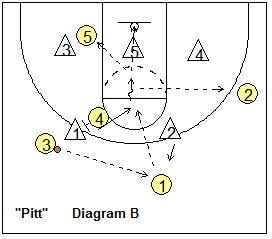
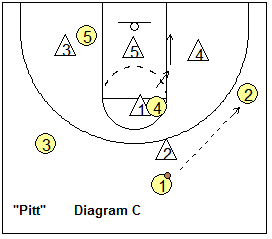
Meanwhile, O4 seals the X1 defender and cuts inside and gets the open pass from O1. O4 can shoot here, attack with one-dribble and a jump shot, pass inside to O5, or kick it out to O2 on the wing. If O4 does not receive the pass, he floats down in the gap along the ballside lane line as the ball is passed to O2 (diagram C). O4 will end up near the block.
As O4 gets to the low block the opposite post O5 X-cuts to the ball-side elbow (diagram D), and he could get the pass here from O2. As the ball is passed back out to O1 (diagram E), O5 ball-screens. O1 passes to O3 and O5 seals the X2 defender and cuts inside for the pass from O3 (diagram F), and now O5 has the same inside options.
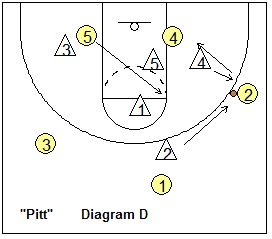

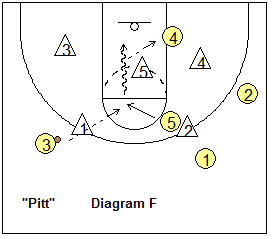
If O5 does not receive the pass, he finds the gap along the ballside lane line (diagram G), and will move down to the block. This triggers O4 to cut to the ballside elbow, and we are back where we started in diagram A. Diagram H shows O4 ball-screening once again.
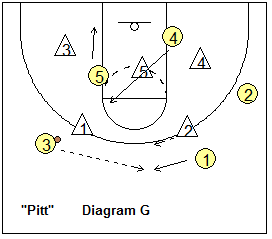
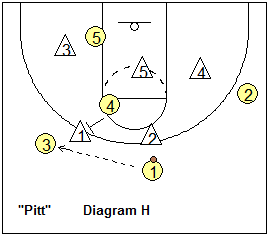
Ball-screening the top two defenders, combined with the posts working together and X-cutting, was very effective for Pitt.
Let's look at some other ways of screening the 2-3 zone.
The rest of this article is in the Premium Members section or the Playbook download.
Sign up now!
The complete article also includes:
It also includes these tactics:
- screening the 2-3 zone (backside pin and skip, screen and dribble-attack, crack-back screen)
- screening the 1-3-1 zone
- screening the 1-2-2 zone
Also see: Anchors Zone Offense

